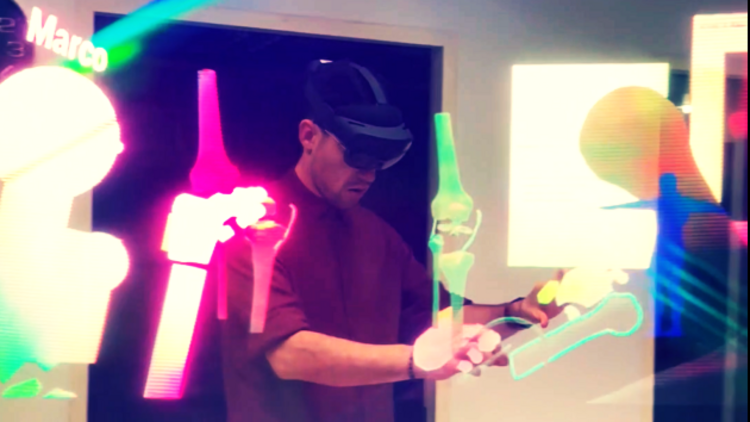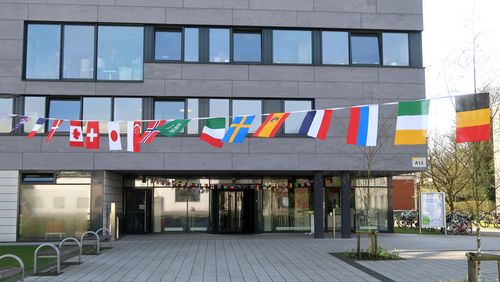Supported by the German Academic Exchange Service, lecturers from Oldenburg and Bangkok (Thailand) have developed an augmented reality (AR) seminar that enables medical students from both countries to learn together.
A small group of students and their lecturers are standing together in a seminar room at the University of Oldenburg. They are all wearing AR glasses. Through them they can see their normal surroundings and the people around them, but also much more: a virtual three-dimensional knee joint and the corresponding X-ray images float in the room. There are also several white avatars without faces or lower bodies. They represent the students and lecturers who are currently standing at Mahidol University in Bangkok, Thailand, looking at the same knee joint.
The partners from Oldenburg and Bangkok spent six months working on the joint teaching unit as part of the Virtual Seminar - Anatomy and Orthopaedics project funded by the German Academic Exchange Service. They had to start almost from scratch. "Our Thai partners first modelled a shoulder and a knee joint themselves for this module," explains Prof. Dr Anja Bräuer, who coordinated the project on the Oldenburg side.
The anatomy and orthopaedics lecturers had specific requirements for the models. Firstly, the students had to be able to familiarise themselves with the anatomy of the joint, muscle attachments, ligaments and important nerves in as much detail as possible during the first part of the seminar. The students also had to be able to move the model around the room, change its size and remove individual structures. Secondly, the Thai partners had to program not only healthy joints, but also an injured joint. In the second part of the seminar, the students had to act as doctors and work together to diagnose the injuries to the body parts. The teachers had constructed specific cases from the field of orthopaedics: a student who fell from a ladder while painting complained of shoulder pain, and a footballer had knee problems after a fall.
"The project has shown that AR technologies have a promising future in teaching," says Bräuer. She can easily imagine AR being used to allow students to look over a lecturer's shoulder as she works with real patients in a hospital, with their X-rays floating around the room. There could also be benefits for specialist training if teachers and students do not necessarily have to be in the same place. "For example, future specialists could learn from experts from all over the world," says Bräuer. And as long as Oldenburg does not have its own wet anatomy centre, the technology could be another way for students to study the structure of the human body in three dimensions - an opportunity they currently only have in courses that require them to travel to the anatomy department in Groningen.
However, there is still a lot of pioneering work to be done before an AR seminar becomes a regular part of the Oldenburg medical students' curriculum, says Bräuer. As well as the technical hurdles - in this project, for example, problems understanding participants at the other end of the room when they are moving around at the same time - the German-Thai team have identified other challenges. "There are hardly any social conventions when using the technology. Just as we all had to agree on how to behave in videoconferences at the beginning of the pandemic, such agreements are also needed in AR," she points out. In fact, they are particularly important there because people who are not in the same place have only been represented as mimicless avatars. "We have learnt how important facial expressions are in teaching when it comes to assessing whether someone wants to participate," says Bräuer. This makes it difficult to communicate with people who are not in the same room.
After six months of virtual encounters, a delegation from Oldenburg - including the four students who took part in the intercontinental seminar as test subjects - visited Bangkok in December. In addition to getting to know each other in "real life", the focus was on analysing the experiences made at a distance. The visit also marked the formal end of the project. However, the partners from both countries want to continue developing the virtual seminar together. Bräuer was joined on the Oldenburg side by PD Dr Veysel Ödemis and Dr Esther Maier from the Department of Anatomy and Dr Ricarda Stauß, a lecturer in orthopaedics. Contact with Mahidol University was established through Prof. Dr Peter Haddawy, who is not only a professor at Bangkok University but has also been a fellow of the Hanse-Wissenschaftskolleg in Delmenhorst several times.
The team led by Prof. Dr Dirk Weyhe, Director of the University Clinic for Visceral Surgery at the Pius Hospital, will also play an important role in the collaboration - Weyhe is also researching AR technologies. He is investigating their potential applications in the operating theatre.






